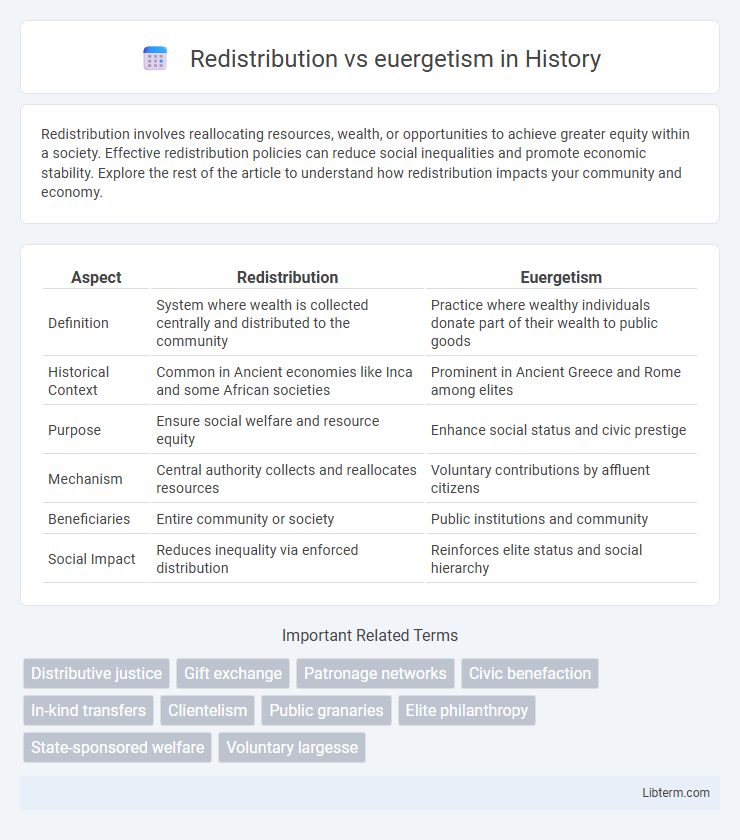Redistribution involves reallocating resources, wealth, or opportunities to achieve greater equity within a society. Effective redistribution policies can reduce social inequalities and promote economic stability. Explore the rest of the article to understand how redistribution impacts your community and economy.
Table of Comparison
| Aspect | Redistribution | Euergetism |
|---|---|---|
| Definition | System where wealth is collected centrally and distributed to the community | Practice where wealthy individuals donate part of their wealth to public goods |
| Historical Context | Common in Ancient economies like Inca and some African societies | Prominent in Ancient Greece and Rome among elites |
| Purpose | Ensure social welfare and resource equity | Enhance social status and civic prestige |
| Mechanism | Central authority collects and reallocates resources | Voluntary contributions by affluent citizens |
| Beneficiaries | Entire community or society | Public institutions and community |
| Social Impact | Reduces inequality via enforced distribution | Reinforces elite status and social hierarchy |
Understanding Redistribution: Concepts and Context
Redistribution involves the systematic transfer of resources from one group to another to achieve social equity, often implemented through taxation, social welfare programs, and public services. Its context varies across political and economic systems, influencing how wealth and opportunities are allocated to reduce inequality. Understanding redistribution requires analyzing the mechanisms, goals, and societal impacts that differentiate it from euergetism, which centers on voluntary elite generosity rather than structured economic policies.
Defining Euergetism: Historical Overview
Euergetism, rooted in ancient Greek and Roman societies, refers to the practice of wealthy individuals voluntarily distributing their wealth to benefit the public, often through funding public works, festivals, or charitable activities. Unlike state-enforced redistribution, euergetism operates as a form of elite philanthropy that reinforces social hierarchies while promoting civic pride and communal welfare. Historical examples include the sponsorship of temples, theaters, and infrastructure projects by affluent citizens as a means to gain social prestige and political influence.
Key Differences Between Redistribution and Euergetism
Redistribution involves the systematic allocation of wealth or resources by a central authority to achieve social equity, often through taxation and public services. Euergetism refers to voluntary acts of giving or benefactions by wealthy individuals aimed at gaining social prestige or political influence. The key difference lies in redistribution being institutional and compulsory, while euergetism is informal and voluntary, driven by personal or social motives.
Historical Examples in Ancient Societies
Redistribution in ancient societies is exemplified by the Inca Empire, where the state collected surplus goods and redistributed them to ensure social stability and support state functions. Euergetism, prominent in ancient Rome, involved wealthy elites funding public works, games, and distributions to gain political favor and social prestige. These contrasting systems highlight how centralized control versus elite generosity shaped resource allocation and social cohesion in historical contexts.
Economic and Social Impacts of Redistribution
Redistribution of wealth through progressive taxation and social welfare programs reduces income inequality and promotes economic stability by increasing the purchasing power of lower-income groups. It fuels social cohesion by addressing disparities, enabling access to education and healthcare, and mitigating poverty-related issues. Unlike euergetism, which relies on elite-driven voluntary donations, redistribution institutionalizes resource allocation to systematically enhance social equity and economic resilience.
The Role of Euergetism in Political Power
Euergetism, the practice of wealthy individuals distributing wealth to the public, reinforces political power by fostering loyalty and social cohesion among constituents. Unlike state-led redistribution that aims to balance economic inequalities through formal policies, euergetism operates through voluntary elite generosity, enhancing the patron's prestige and influence. This reciprocal relationship strengthens hierarchical social structures and sustains elite dominance over political decision-making processes.
Redistribution in Modern Policy Making
Modern policy making emphasizes redistribution as a strategic tool to address economic inequality and promote social welfare through targeted fiscal measures such as progressive taxation and social transfers. Redistribution involves the deliberate allocation of resources from wealthier segments of society to support education, healthcare, and social safety nets for disadvantaged populations. This approach is supported by empirical evidence demonstrating its effectiveness in reducing poverty rates and fostering inclusive economic growth.
Euergetism and Social Prestige: Motives and Outcomes
Euergetism, rooted in ancient practices, involves wealthy individuals voluntarily distributing resources to benefit the community, driven primarily by the acquisition of social prestige and political influence. This form of philanthropy often serves as a strategic tool for elites to assert status, legitimize authority, and reinforce social hierarchies without formal state intervention. The outcomes of euergetism include enhanced public infrastructure and cultural patronage, alongside the perpetuation of elite dominance through reciprocal social obligations.
Comparative Effectiveness: Equity vs. Elitism
Redistribution prioritizes equity by reallocating resources from the wealthy to broader populations, aiming to reduce socioeconomic disparities and enhance social welfare. In contrast, euergetism exemplifies elitism through voluntary elite philanthropy, where the wealthy selectively distribute wealth to gain prestige and reinforce social hierarchies. Comparative effectiveness reveals redistribution fosters systemic equity, while euergetism often perpetuates inequality by sustaining elite dominance.
Future Perspectives: Balancing Redistribution and Euergetism
Future perspectives on balancing redistribution and euergetism emphasize integrating state-led redistribution policies with community-driven euergetic practices to enhance social cohesion and sustainable development. Strategic frameworks prioritize equity and local empowerment by combining progressive taxation and welfare systems with culturally resonant philanthropy and patronage. Emerging models highlight the potential of digital platforms and social innovation to facilitate transparent, efficient resource allocation that respects historical traditions while addressing modern socioeconomic challenges.
Redistribution Infographic

 libterm.com
libterm.com